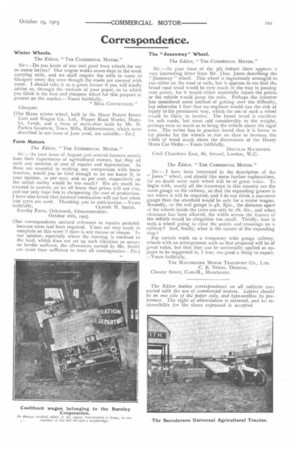Correspondence.
Page 15

If you've noticed an error in this article please click here to report it so we can fix it.
Winter Wheels.
The Editor, " THE Commeactar. MOTOR."
Sir :•—Do you know of any real good frost wheels for use on motor lorries? Our wagon works seven days in the week carrying milk, and we shall require the milk to come to Glasgow every day even though the roads are covered with snow. I should take it as a great favour if you will kindly advise us, thtough the medium of your paper, as to which you think is the best and cheapest wheel for this purpose at present on the market.-Yours faithfully,
" MILK CON VEYANCE. "
Glasgow.
rrhe Mann winter wheel, built by the Mann Patent Steam Cart and Wagon Co., Ltd., Pepper Road Works, Huns. let, Ixeds, and a form of snow-shoe built by Mr. I). Parkes Goodwin, Town Mills, Kidderminster, which were described in our issue of June 22nd, are suitable.—Eol
Farm Motors
The Editor, "THE COMMERCIAL MOTOR."
Sir :—In your issue of August 31st several farmers contribute their experiences of agricultural motors, but they all omit any mention of cost of repairs and depreciation. As these are essential in making any comparison with horse traction, would you be kind enough to let me know if, in your opinion, to per cent. and 20 per cent. respectively on the initial outlay would be too much? We are much interested in motors, as we all know that prices will not rise, and our only hope lies in cheapening the cost of production. I have also heard that internal combustion will not last when iron tyres are used. Thanking you in anticipation.—Yours
faithfully, CLAUDE M. SMITIf Fernley Farm, Ozlieworth, Gloucestershire. October 16th, I905.
[Our correspondents omitted reference to repairs probably because none had been required. Users are very ready to complain on this score if there is any excuse or reason. In our opinion, especially where the running is confined to the land, which does not set up such vibration as occurs on harder surfaces, the allowances named by Mr. Smith are more than sufficient to meet all contingencies.—Eni
The "Jortesway" Wheel.
The Editor, " THE COMMERCIAL MOTOR."
Sir :—In your issue of the 5th instant there appears a very interesting letter from Mr. Thos. Jones describing the " Jonesway " wheel. This wheel is ingeniously arranged to run either on the road or rails, but it appears to me that the broad road tread would be very much in the way in passing over points, for it would either materially injure the points or the vehicle would jump the rails. Perhaps the inventor has considered some method of getting over the difficulty, but otherwise I fear that no engineer would run the risk of injury to his permanent way, which the use of such a wheel would be likely to involve. The broad tread is excellent for soft roads, but must add considerably to the weight, perhaps even so much as to bring the vehicle above the legal tare. The writer has in practice found that it is better to lay planks for the wheels to run on than to increase the width of tread much above the dimensions of the Heavy Motor Car Order.—Yours faithfully,
DOUGLAS MACKENZIE.
Cecil Chambers East, 86, Strand, London, W.C.
The Editor, "THE COMMERCIAL MOTOR."
Sir :—I have been interested in the description of the " Jones " wheel, and should like some further explanations, for no doubt some such wheel will be of great value. To begin with, nearly all the tramways in this country are the same gauge as the railway, so that the expanding groove is not where it will be required, and I do not think a narrower gauge than the standard would be safe for a motor wagon. Secondly, as the rail gauge is 4ft. 8iin., the distance apart of the wheels inside the tyres can only be 2ft. 6in., and when clearance has been allowed, the width across the frames of the vehicle would be altogether too small. Thirdly, how is such a wheel going to clear the points and crossings on a railway? And, finally, what is the nature of the expanding ring?
For certain work on a temporary wide gauge railway, wheels with an arrangement such as that proposed will be of great value, but that they can be universally applied as appears to be suggested is, I fear, too good a thing to expect. —Yours faithfully, TIIE MANCHESTER MOTOR TRANSPORT Co., LTD. C. B. NIXON, Director.
Chester Street, C-on-M., Manchester.
The Editor invites correspondence on all subjects connected with the use of commercial motors. Letters should be on one side of the Paper only, and type-written by preference. The right of abbreviation is reserved, and no responsibility for the views expressed is accepted.


















